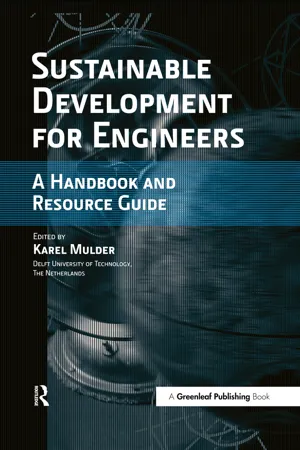
- 288 pages
- English
- ePUB (mobile friendly)
- Available on iOS & Android
About This Book
It is crucial that engineers – from students to those already practising – have a deep understanding of the environmental threats facing the world, if they are to become part of the solution and not the problem. Is there a way to reconcile modern lifestyles with the compelling need for change? Could new improved technologies play a key role? If great leaps in the environmental efficiency of technologies are needed, can they be produced? Engineers are in a privileged and hugely influential position to innovate, design and build a sustainable future. But are they engaged or uninterested? Are they knowledgeable or ignorant? This book has been developed by a number of committed educators in European engineering departments under the leadership of Delft University of Technology and the Technical University of Catalunya to meet the perceived gap between what engineers know and what they should know in relation to sustainable development. The University of Delft decided as long ago as 1998 that all of its engineering graduates, working towards careers as designers, managers or researchers, should be prepared for the challenge of sustainable development and, as such, should leave university able to make sustainable development operational in their designs and daily practices. The huge amount of knowledge gathered on best-practice teaching for engineers is reflected in this book. The aim is to give engineering students a grounding in the challenge that sustainable development poses to the engineering profession, the contribution the engineer can make to attaining some of the societal and environmental goals of sustainability, and the barriers and pitfalls engineers will likely need to confront in their professional lives. Concise but comprehensive, the book examines the key tools, skills and techniques that can be used in engineering design and management to ensure that whole-life costs and impacts of engineering schemes are addressed at every stage of planning, implementation and disposal. The book also aims to demonstrate through real-life examples the tangible benefits that have already been achieved in many engineering projects, and to highlight how real improvements can be, and are being, made. Each chapter ends with a series of questions and exercises for the student to undertake. Sustainable Development for Engineers will be essential reading for all engineers and scientists concerned with sustainable development. In particular, it provides key reading and learning materials for undergraduate and postgraduate students reading environmental, chemical, civil or mechanical engineering, manufacturing and design, environmental science, green chemistry and environmental management.
Frequently asked questions
1 Why do we need sustainability?
Easter Island

Source: reproduced with permission from Jan Boersema
- Creating the statues required a great deal of labour. As most statues date from between 1400 and 1600, Easter Island society would have had to be far more prosperous and far better organised at that time to be able to support these efforts
- Transportation methods that did not use wood would have been very risky for the statues and probably inadequate on the rougher terrain
Unsustainable societies collapse
- When irrigation is used, agriculture yields good harvests in the beginning. But when the water evaporates on the land, it leaves salt in the top layer. Plants are poisoned by too much salt; soon yields start to decline and the land can no longer be used for agriculture. There is evidence that this phenomenon contributed to the collapse of the civilisations of the Maya in Central America, the Indus Valley in southern Asia and Mesopotamian cities in the Middle East
- When agricultural land is drained, hydrostatic pressure can force saline water to rise from lower layers. This can also lead to salt poisoning
- Irrigation often contributes to erosion, removing the productive top layer of soil from the agricultural land. Erosion can also lead to dust storms, which can themselves pose a threat to farms and villages. In the 1930s, the so-called Dust Bowl, caused by years of low rainfall and extensive agricultural production, created a severe problem in the Midwest of the USA. Throughout the world, communities have been destroyed by land erosion
- When the population grows, the increasing need for food can lead to extensive monocultural (single-crop) land use. This can l...
Table of contents
- Cover
- Half Title
- Title
- Copyright
- Contents
- Acknowledgements
- Introduction
- 1 Why do we need sustainability?
- 2 Why is the current world system unsustainable?
- 3 Patterns of development
- 4 Sustainable development and economic, social and political structures
- 5 Technology: the culprit or the saviour?
- 6 Measuring sustainability
- 7 Sustainable development and the company: why, what and how?
- 8 Design and sustainable development
- 9 Innovation processes
- 10 Technology for sustainable development
- Index